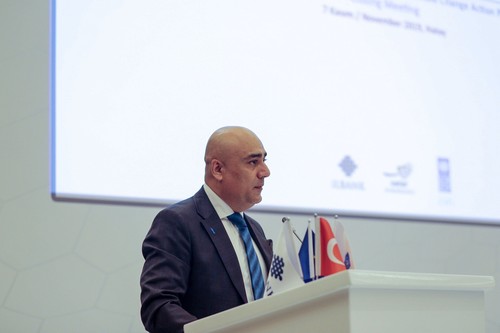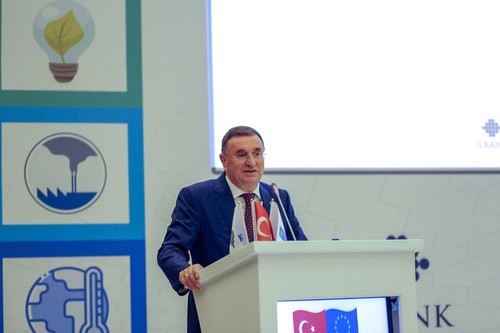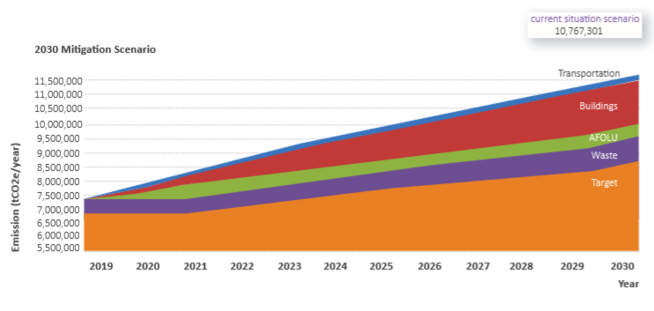The Hatay Metropolitan Municipality in southern Turkey announced Thursday its plans to reduce carbon emissions by 23% by 2030.
The commitment – 2% above the national average – will be backed by the United Nations Development Program and İlbank. In doing so, Hatay, which has already been tested by a growing influx of Syrian refugees, has proved that it is ready to take on another challenge and take bold steps to combat the effects of climate change.
The municipality revealed its plans at the closing meeting of the EU-funded "Carbon Footprint Inventory and Climate Change Action Plan" project, held at the Museum Hotel Antakya, the world's first museum-hotel hybrid. It joins 16 other cities in mapping out a "Climate Change Action Plan (CCAP) to create "low-carbon, sustainable and habitable cities."
The project will provide capacity building training to municipality personnel, update the greenhouse gas emission (GGE) inventory and develop a web-based module for the follow-up of the implementation of the CCAP.
Speaking at the program, UNDP Turkey Communications Director Faik Uyanık said due to the increase in temperatures stemming from climate change, the Mediterranean Basin, which Turkey and Hatay is a part of, is facing a high risk of drought. "There may also be significant drops in the water levels of streams," Uyanık said.
Hatay is one of Turkey's high-risk areas in terms of low water levels and drought. "We won't call this 'climate change' anymore, this is an emergency. From now on, we'll use 'climate crisis' instead," Uyanık added.
The head of Hatay Metropolitan Municipality's Environmental Protection and Control Department, Ahmet Dolğun said the project, which was launched on Feb. 23 and completed in September, created various scenarios to reduce greenhouse gas emissions throughout the city until 2030.
"We conducted two workshops on July 3 and July 31. We assessed the current situation and worked on separate mitigation actions for each sector. In the end, we determined strategies to reduce greenhouse gases," he said, adding that Hatay was now a step closer to the 2030 target set in the Paris Agreement.

Speaking at the same program, Sukhrob Khojimatov, UNDP deputy resident representative, thanked Turkish people for their "remarkable and tremendous generosity" toward Syrians. He said Turkey should be a role model for the world. Hatay currently hosts 438,696 Syrian refugees, almost a third of its 1.6 million population.
He stressed that population growth has had an undeniable impact on environmental health and population movements were "increasingly linked to environmental concerns and climate change."
"At the local level for a municipality like Hatay, which witnessed a sudden increase of 25% in its population, this additional refugee population represents an increase in waste and wastewater generation, reducing landfills life cycle and contributing to the increasing greenhouse gas emissions," he said.
He added that such crises needed holistic and integrated solutions. Khojimatov said this became apparent when they realized the environmental impact of an expanded population.
"Our initial support focused on the provision of fire-fighting and emergency vehicles to respond to the increasing number of accidents and fires. However, we quickly realized that a more comprehensive approach was needed to make a real difference in supporting the efforts of the municipality to extend services to the expanded population. This led us to invest in major infrastructure projects ... to support Hatay municipal services, such as the construction of solid waste transfer stations and construction of a wastewater treatment plant," he said.
He also warned that environmental pollution and climate change could displace even larger populations. More than 265 million people were displaced due to climate changes between 2008-2018. In 2018 alone there were more than 7.2 million climate refugees, the UNDP representative said.
Deputy Director General of İlbank Emrah Baydemir drew attention to the cooperation aspect of the project.
He said the world has started to feel the crippling effects of climate change and added that action plans, laws and regulations were all important steps, but the most crucial part was what will actually be done out in the field to realize them.
"We, as İlbank, are prepared to support the local administration both in the technical sense and finance-wise to actualize these plans."
"Along with EU funding, we will help the municipality finance its projects to reduce emissions," he said, adding, "In line with the U.N.'s sustainable development goals, we will create flexible and resilient cities."

Hatay Mayor Lütfü Savaş blamed humankind's hunger for consumption for climate change and ensuing disasters.
He said the rapid advance of technology, as much as it was a necessity, also brought along many problems, such as environmental pollution.
The mayor called it a catch-22 situation, likening it to drinking salty seawater, "The more you drink it, the thirstier you will get."
He added that individuals, alongside local administrations, can play a major role in reducing greenhouse gas emissions.
So what was Hatay's climate change report card like?
The action plan took 2017 as its starting point, summarizing the emissions caused by each sector for the year as follows:
Stationary energy sources: 7,573,956,62 tCO2e/year
Transportation: 1,775,762,42
Solid waste - wastewater: 42,634,65
Industrial processes and use of industrial products: 6,867,941
Agriculture, forestry and other uses of land: 993,559,29
– giving us a grand total of 17,636.853,98.
This translates to 3.2 tCO2e/person, significantly lower than Turkey's per capita figure of 6.6 tCO2e/person.
However, without the CCAP, projections show that per capita emission will increase up to 4.9 tCO2e/person in Hatay in the coming years. If the plan is implemented to a "T," per capita emission will decrease to 3.7 tCO2e/person by 2030, and annual emissions will drop to around 8,286,910 tCO2e/year, down 23% from 10,767,301 tCO2e/year.

In light of these statistics, experts teamed up and categorized the measures into four main sectors:
ENERGY
On the energy front, the action plan foresaw heat insulation for all buildings and a switch to natural gas instead of coal.
In line with the Mediterranean climate in the region (warm all year round with an average annual temperature of 18 degrees Celsius in hot and dry summers), air-conditioning systems in the city should be replaced with those with an energy rating of A+++ or higher, and A+ or higher for electrical home appliances.
The municipality's future buildings will be fully sustainable and incorporate designs suited for that purpose under the plan.
TRANSPORTATION
Optimizing bus lines and traffic light durations, increasing the capacity of public vehicles and promoting them, installing smart junction management systems and building underpasses for spots prone to congestion were some of the measures listed in the plan in this area.
From now on, all public transport vehicles in traffic in Hatay will be no older than 15 years and be renewed accordingly. The current fleet will gradually be transformed into an eco-friendly one.
Bicycle and electric vehicle use will be promoted while incentives such as free parking or designated parking spaces will be provided to citizens to ease and expedite the switch from diesel cars.
WASTE
Ameliorating waste collection and disposal services, creating more facilities and increasing capacities of wastewater treatment plants; using renewable energy sources to power such facilities; creating separate channels for wastewater collection and installing rainwater recovery and treatment systems were the measures listed in the action plan under waste management.
The province also currently generates electricity for 15,000 households from collected waste, Mayor Savaş said. Hatay also plans to build new wind turbines to generate more of its electricity from renewable sources. The province has huge potential in this sense, Savaş said.
AGRICULTURE AND FORESTRY
Switching to nitrogen-based and more nutritious supplements for grazing animals has the potential to reduce emissions from enteric fermentation. Throughout the province, especially in cattle farming capitals such as Reyhanlı, Yayladağ and Kırıkhan, anaerobic digestion (biogas) plants will be built, which could help reduce methane emissions through centralized manure collection, storage and processing, therefore reducing the carbon footprint in the agricultural sector.
In line with the plan, the municipality will also promote organic farming and composting, up its reforestation efforts in the city for more parks, bike lanes and green areas, and create a food sharing/donation system to reduce collective food waste.
*Yasemin Nicola Sakay